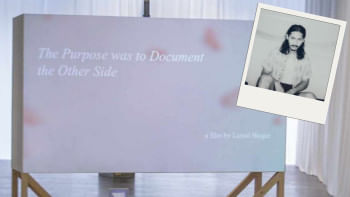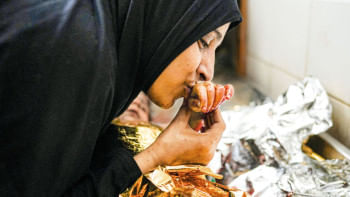All of the flavours: Laisul Hoque on winning 2025 East London Art Prize

What makes a visual artist tick in the cacophony of your typical modern existence, which in hindsight has the tenacity to make one increasingly distracted? One of the answers lies with the recently declared winner of the second iteration of the 2025 East London Art Prize, Laisul Hoque. This all-media art prize competition received 900 submissions from artists and collectives living or working within London's 'E' postcode this year. Laisul won £15,000 (over $15,000) and the opportunity to host a solo exhibition at the Nunnery Gallery in Bow, scheduled for 2026, owing to his interactive installation art piece "An Ode to All the Flavours" (2024), which was selected from 12 shortlisted artists.

Speaking exclusively with The Daily Star over the phone from the UK, Laisul talked about "An Ode to All the Flavours", at length. The artist based his creation on one of his earliest and fondest memories with his father — from the time they went grocery shopping during a visit to their village, and his father took a detour to share the unconventional combination of spicy fried jhuri and the sweet flavour of bhundia, with him in a sweet shop.
Laisul explained the meaning behind his project and recalled, "It was funny because the shopkeeper of the sweet shop wasn't familiar with this combination of food. The moment, however, stands as a core memory of my father showing emotion despite being conditioned not to do so, as a result of being raised in a surrounding cultivated by traditional hegemonic masculinity."
"Interestingly, my conventional father used to always tell me to adhere to the rules by never challenging them and yet he had the most unconventional preference for snacking. In my way, I tried to convey this oxymoron through the art installation by turning it into an expanded form of storytelling in the exhibition — so that people can come in and try the food to engage with my story."

In response to being asked about the reception of the art and whether he considered that this innately Bengali theme could have been exoticised, Laisul conveyed, "The installation has been arranged to be more of a reciprocal experience, in the sense that viewers can visualise my lived experience while also tasting something similar to the flavour that lingers from my childhood memory. East London's art scene is extremely diverse so a project that unabashedly portrays its culture is rather ordinary here. The art might include cultural signifiers (symbols that are obvious to people belonging to the same culture) but unaware audiences can use this opportunity to learn more about bhundia and jhuri. If, for some, the art does come off as bizarre then so be it, because it was my lived experience and I can't create art if I deny my lived experience."
He shared that Oitij-jo Kitchen, a social enterprise in East London, has been supplying food for "An Ode to All the Flavours". Laisul provided a bit of a reality check for many Bangladeshi expatriate housewives in London, who were married off for a better life but left to attend solely to household duties once they arrived. Oitij-jo Kitchen especially offers financial independence to such restricted women through job opportunities. They also host workshops by artists, including those offered by the likes of Laisul to present learning opportunities for the women of the business and anyone who might be interested in learning more about art and culture.

When inquired about what made him choose his journey into the art world, Laisul unflinchingly credited his need to express himself. "It was difficult for me to communicate within my household due to navigating two distinct realities within and outside my home. My education at an English medium school taught me to express myself in a language my parents didn't have an effortless connection to. In this amalgamation of a confused and hybrid culture of growing up, I found contemporary art. I can always depict my personal experiences through my artwork, devoid of linguistic barriers, and put them out there in the world among other creatives," Laisul shared.
When we began treading the line of reflecting on the difference between the local and foreign art scenes, Laisul confessed, "Major overhauling decisions need to be made on administrative and policy-making levels and the government needs to care enough about it to get things done financially. There is a concrete structure to helming the workings of the art world in London including vested interests in becoming gallerists and art critics to sustain the field with the help of continued government funds, for example. However, I've noticed the Bangladeshi art and craft markets nowadays are getting necessary attention through initiatives like 'Dhaka Art Summit', 'Arka Fashion Week', and 'Dhaka Makers', which is a good start."

In ruminating on potential ways to strengthen the evolution of the Bangladeshi art scene at the communal level, Laisul offered his understanding, "It won't happen overnight. Art as a medium has proven to be potent time and again — artists have changed governments and laws through their artworks. Art has also been held as legal proof for and against governments. There is an archival website called Arte Útil (Useful Art) which is an ever-growing catalogue of mass social impacts recorded through reality-shifting artworks."
"I, for one, was so driven by all that I've witnessed within the ways of the art world that I got my MA in Contemporary Photography, Practices, and Philosophies at Central Saint Martins, UAL, London to utilise it as an access point to the field. If people with experiences like us return to Bangladesh to provide a platform to assemble a structure to traverse the artistic terrain unitedly then it can be a way forward. We can also obtain potential support from taxes and foreign development funds for everyone waiting to share their lived experiences.
When asked about his upcoming plans in the field of visual artistry, Laisul expressed, "I would like to focus on building and exploring my art practice a lot more. The prize money will help to develop my solo show in a year, which I know is a rare opportunity. My art practices tend to be multidisciplinary so they take the shape of image-based work such as films, photos, installations, and even sculptures. In essence, I'm trying to make sense of my world and I think that will take the form of making my presence known in galleries so that years later it can be looked back on as a way to understand our past."

 For all latest news, follow The Daily Star's Google News channel.
For all latest news, follow The Daily Star's Google News channel. 





Comments